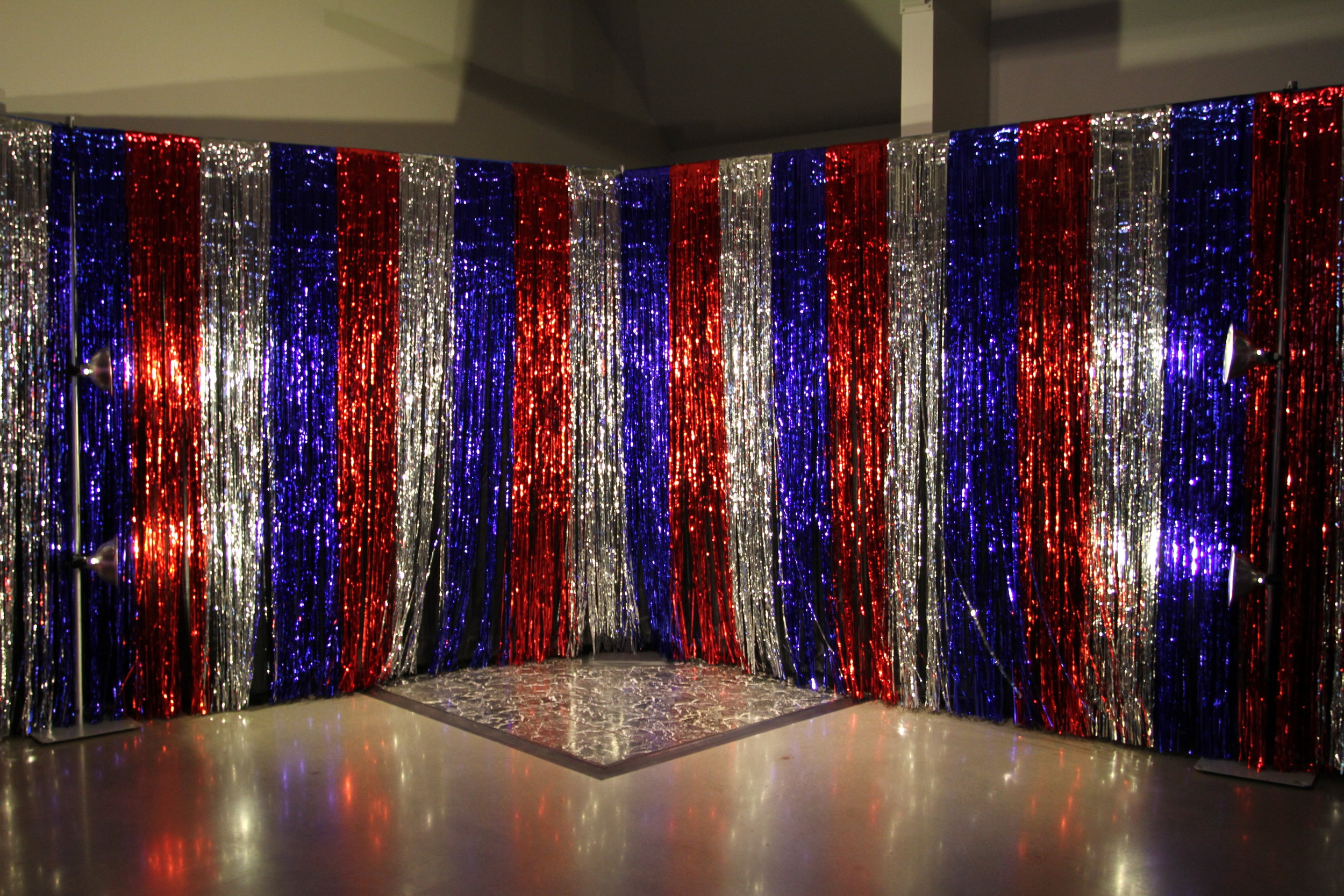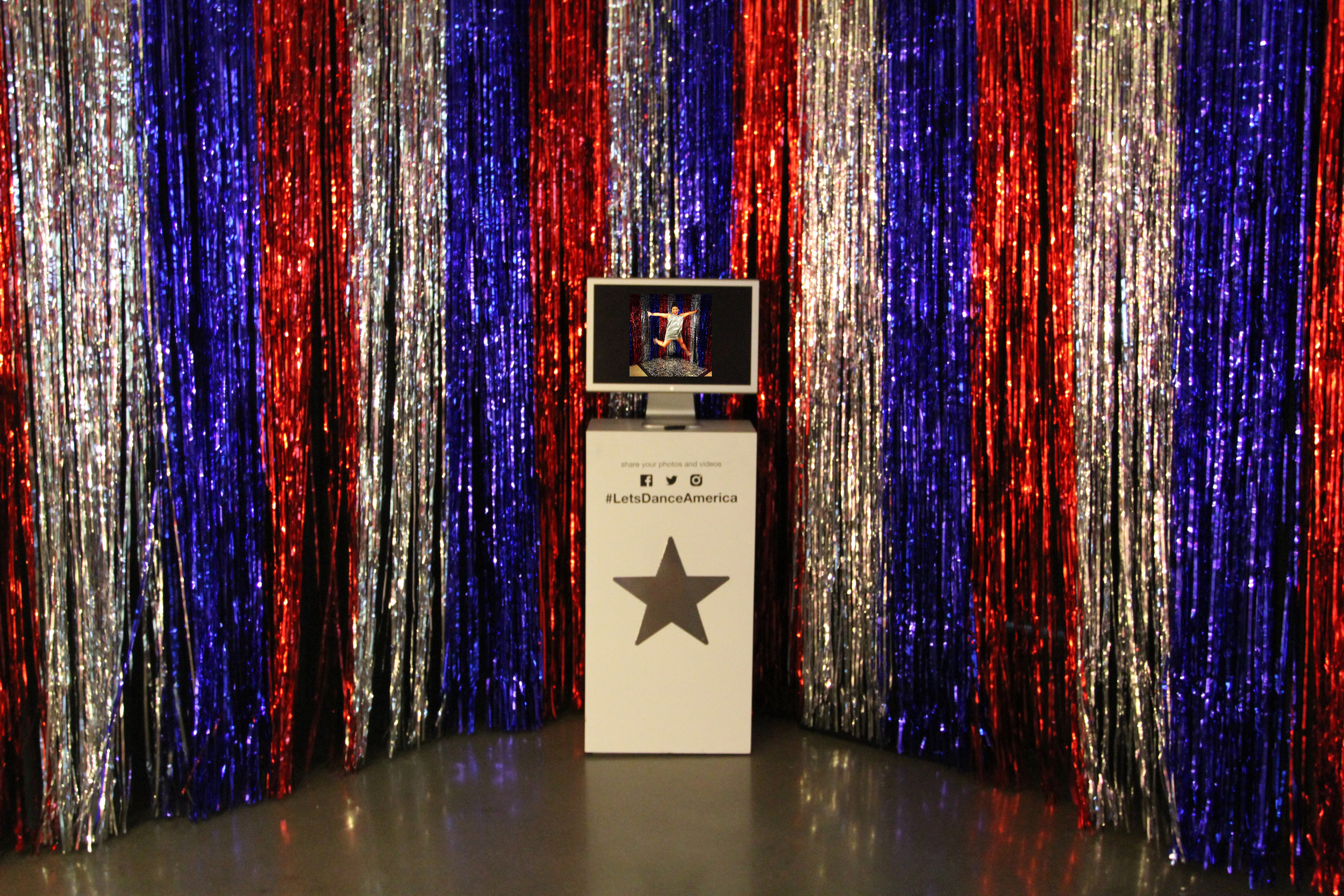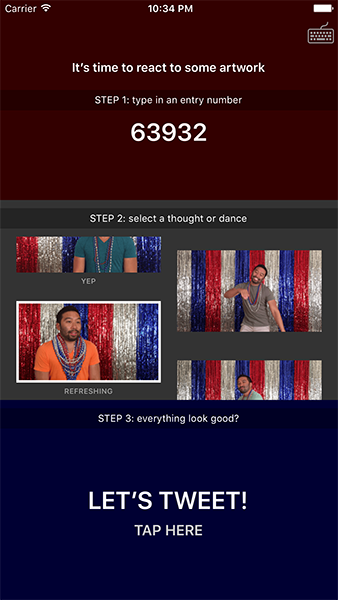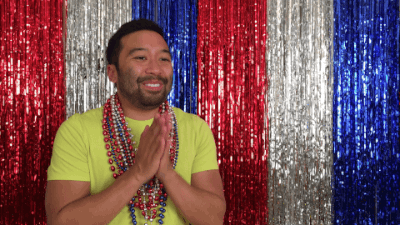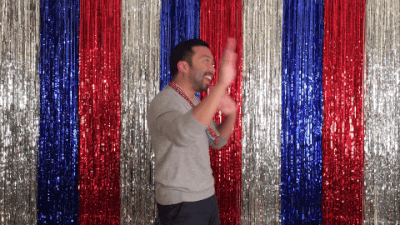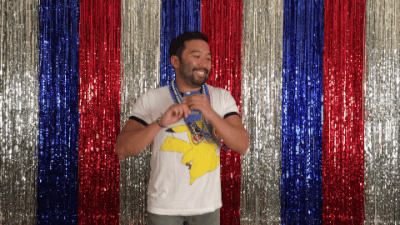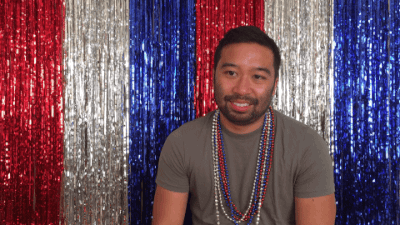video still from Let's Dance America!
Let's Dance America!
2016
multi-media installation
52-minute single-channel video with audio
social media components including a selfie station, a hashtag #LetsDanceAmerica, a geolocation Snapchat filter, and an iPhone app titled Yay America!
Let’s Dance America! is a multi-media installation. A 52-minute video plays in the installation which is comprised of 23 short stories that I have collected and written, and then perform for the camera. Each story begins with an answer to the question: "when and where did you first learn the Macarena". Woven between the stories are dance breaks from each character performing the popular dance. 2016 is the 20th anniversary of the "Macarena (Bayside Boys Remix)" reaching the top of the Billboard Top 100 (August 3, 1996). That year in 1996, the song went viral during the U.S. Presidential Election. While the song itself acts as the common denominator for the stories, each story transpires into one of many personal yet familiar experiences that address a variety of themes including dance, the body, love, faith, family, nationalism, tragedy, and celebration.
In 1996, the use of the word viral was hardly a term used in the context of internet popularity. Instead, this word was most associated with a kind of disease or infection, particularly the AIDS and HIV crisis plaguing the gay community of the 1980's. In 1996, American artist Felix Gonzalez-Torres died of AIDS related causes. His artwork, which includes large installations of beaded curtains and corner installations made of wrapped candies meant to be consumed by visitors, continued the artistic identity of gay culture through subversive means. Felix's representations of love, loss, and death were manifestations of his own personal relationships, as well as important events for American gay men, including the 1992 FDA recommendation of a lifetime ban on blood donation by 'men who have sex with men,' and the 1994 military policy of 'don't ask don't tell'.
Interestingly, in 1992, the original Macarena song by the Spanish duo Los Del Rio was recorded, and by 1994, the song had gained popularity in several Latin American countries, as well as at a local dance night in Miami. Due to a policy of a local radio station to not play Spanish-only records, Miami DJ "Jammin" John Caride tapped the Bayside Boys to create an English version remix, which went viral in 1996 thanks in part to a number of factors including an initial fanbase, a catchy tune, an easy dance, and a distribution by record giant RCA.
While the primary element of Let's Dance America! is a looping 52 minute video, its debut at ArtPrize requires a bit more pizzazz for the annual art competition in Grand Rapids, Michigan. Presented at the Urban Institute for Contemporary Arts in the exhibition titled FUTURE TALK curated by Heather Duffy, Let's Dance America! includes several more components. Within a large room, the video is projected against sparkling walls of red, silver, and blue foil curtains. At one corner of the room, a dance floor is installed and mini-spotlights point above the dance floor. This area marks the selfie station for visitors to snap a pic or dance the Macarena. Another corner houses a monitor that displays a looping slideshow of images taken in the selfie station and uploaded to social media outlets like Twitter, Instagram, and Facebook using the hashtag #LetsDanceAmerica. On the weekends of the exhibition, a Snapchat filter is available for use. And last but not least, a functioning iPhone app titled Yay America! is available for download in the Apple App Store. Yay America! allows users to share and distribute animated gifs of looping footage from Let's Dance America!, while allowing anyone in the world to participate in the conversations at ArtPrize through its 5-digit 'reaction' feature.
The active use of social media allows for a great potential for the stories of Let's Dance America! to go viral. In addition to exhibiting artwork, ArtPrize creates an arena that applauds artist buzz and celebrity. Television, print, and online media news outlets provide exposure for artists. After my unexpected drama at ArtPrize Seven in 2015, my return to ArtPrize 8 was a refreshing welcome, as well as a popular promotional news item with many Grand Rapids community members complimenting me on my positive and energetic spirit. At ArtPrize, an artist's physical presence is an important part of the popular vote.
Because I am unable to be physically present in Grand Rapids for the duration of ArtPrize, I rely on digital elements like my website and social media to be my proxy (in addition to UICA representatives who are familiar with my work). The nature of my artwork allows me to use the sparkly foil curtain background in my San Francisco studio as a remote location to contribute to the Grand Rapids central hub. There are many questions that are asked by the public to artists at ArtPrize, including "what inspired you?" "how long did it take to make?" and "how did you hear about ArtPrize?". My familiarity with ArtPrize comes from participating in the event for four years, once in each category: GayGayGay robe at Westminster Presbyterian Church, 2011; Hosanna at Kendall College of Art and Design, 2012; Revelry at Calder Plaza, 2015; and Let's Dance America! at UICA, 2016.
To answer the process question, Let’s Dance America! took nearly a year of planning. It continues my obsession with the production of self-portraiture through a highly private process. Recorded completely on my iPhone, my words are not delivered to anyone – I’m simply speaking to thin air. I say my lines and pause at the appropriate moment. In post-production, I record my own voice and then filter and insert it into the conversation. Dancing the Macarena 23 times in my studio mimics the mythical behavior performed by American artist Bruce Nauman in his video Walking in an Exaggerated Manner around the Perimeter of a Square (1967-68). Other American art references make cameos throughout Let's Dance America! including a dog balloon by Jeff Koons, and the New Museum of Contemporary Art's inaugural exhibition "Unmonumental: The Object in the 21st Century". And continuing America's obsession with Pop Art and American artist Andy Warhol, a reference to this year's viral hit Pokémon Go was essential.
As much as I am comfortable talking about process and revealing the technical aspects of the artwork, I'm most intrigued by the questions I am able to pose through my artwork. Throughout this text, words have been bolded: viral, positive, and exposure. These three words have been integral to the identity and narrative of American gay culture, such as an HIV viral load, being HIV positive, and the risk of HIV exposure. As a gay American artist whose artwork explores my personal and cultural identities, I am always concerned with continuing the tradition of representing gay identity as many other artists have done before me including Ellsworth Kelly, Andy Warhol, Robert Mapplethorpe, Keith Haring, Felix Gonzalez-Torres, Nayland Blake, Glenn Ligon, Mark Bradford, and Ryan Trecartin. However, in a new American society of legalized gay marriage, serving openly in the military, and the distribution of PrEP -- a daily pill which promises to prevent the transmission of HIV -- what direction should I take the gay language? Where does the anxiety go? What are the new definitions? What is today's artistic representation of a gay American man? (It's ironic for me to pose these questions now, when I clearly know that my anxieties of gay culture have shifted to terrorism in the wake of the Orlando shooting.)
Finally, how can I discuss these issues at ArtPrize? While the city of Grand Rapids is a progressive place, its surrounding areas are more conservative, which is evidenced by the more classic artistic entries that have won the Public Vote Grand Prize, including Mia Tavonatti's Crucifixion in 2011, and two-time winner Ann and Steven Loveless' Sleeping Bear Dune Lakeshore in 2013 and Northwood Awakening in 2015. American artist and former ArtPrize participant Steve Lambert documented his 2014 experience with ArtPrize and its relationship to "the wrong side of the fight for civil rights for LGBT people".
The way to discuss this issue, then, is through subversion. By speaking the art language of ArtPrize -- colorful, large, repetitive, and digitally consumable -- Let's Dance America! can introduce unfamiliar topics to this specific audience. Even if this gay language isn't directly translated to most -- are the sparkly curtains and Macarena not enough? -- its subversive impact will certainly infect all.


